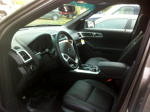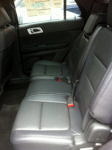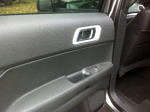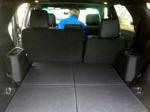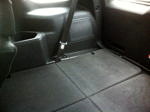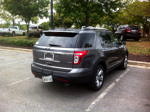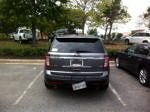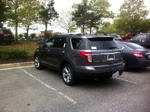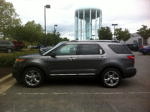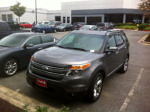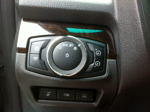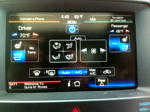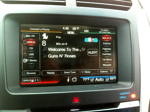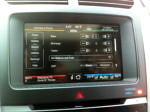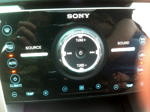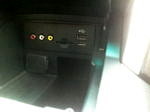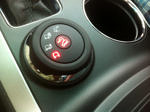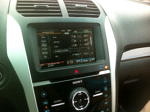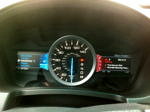 For 2011, Ford released its first full redesign of its storied Explorer since the 2002 update. It’s no longer truck-based, instead owing parts of its underpinnings to Volvo, Ford and Lincoln vehicles. Yet, it rides up high, has 3 rows of seating, a “terrain management” knob for all 4 of its driven wheels, which puts it in the CUV/SUV category. Read on for my driving impressions of Ford’s new Explorer.
For 2011, Ford released its first full redesign of its storied Explorer since the 2002 update. It’s no longer truck-based, instead owing parts of its underpinnings to Volvo, Ford and Lincoln vehicles. Yet, it rides up high, has 3 rows of seating, a “terrain management” knob for all 4 of its driven wheels, which puts it in the CUV/SUV category. Read on for my driving impressions of Ford’s new Explorer.
First off, I must say – I have GOT to stop using my iPhone to take pictures of these test-driven vehicles. While its camera is good, it surely isn’t good enough to do the job here at Road Reality. With that in mind, look forward to future test drives being accompanied by better-quality photographs.
Next, I was genuinely impressed with the new Ford Explorer. While it was the gussied-up Limited 4WD trim, dripping with several thousand dollar’s worth of extras, its basic setup is quite nice.
 The new Explorer is big. Blacked-out A and B-pillars try to hide the size, but from behind the wheel, or actually looking at it up close, it’s a big vehicle. If you’re looking for something that’ll make you feel safe and carry a bunch of stuff or people, the Explorer will fit the bill. While not quite as big as its predecessor, it has gained in the fuel economy area, by a matter or 2-4 MPGs.
The new Explorer is big. Blacked-out A and B-pillars try to hide the size, but from behind the wheel, or actually looking at it up close, it’s a big vehicle. If you’re looking for something that’ll make you feel safe and carry a bunch of stuff or people, the Explorer will fit the bill. While not quite as big as its predecessor, it has gained in the fuel economy area, by a matter or 2-4 MPGs.
 Stepping up into the driver’s seat, you’re welcomed by heated and cooled front seats, as well as leather 2nd and 3rd row seating surfaces. Grabbing the door handle to close it, a welcome thud accompanies the closing of this vault. Yes, I said vault. While entering the Explorer, I asked the salesman if a remote start system was offered, and he tossed me the Ford MyKey, which has a remote start button on it. Pressing it twice caused the SUV to start its engine. Upon entering, I realized I had to press the “Engine Start” button, upon which the instrument cluster lit up. I asked the salesman if I had caused it to shut off the engine, but he informed me that it was indeed running, and a few seconds later, as the tachometer became visible on the dash, it indeed read somewhere between 750 and 850 RPMs. That’s just how quiet and isolated the Explorer feels.
Stepping up into the driver’s seat, you’re welcomed by heated and cooled front seats, as well as leather 2nd and 3rd row seating surfaces. Grabbing the door handle to close it, a welcome thud accompanies the closing of this vault. Yes, I said vault. While entering the Explorer, I asked the salesman if a remote start system was offered, and he tossed me the Ford MyKey, which has a remote start button on it. Pressing it twice caused the SUV to start its engine. Upon entering, I realized I had to press the “Engine Start” button, upon which the instrument cluster lit up. I asked the salesman if I had caused it to shut off the engine, but he informed me that it was indeed running, and a few seconds later, as the tachometer became visible on the dash, it indeed read somewhere between 750 and 850 RPMs. That’s just how quiet and isolated the Explorer feels.
Out on the road, the light steering made it almost too easy to change lanes, except there was no unintentional drifting. The BLIS (blind spot information system) kept me apprised of anybody entering or exiting my blind spots, and good, not great brakes kept me out of the trunk of any cars in front of me. Add in the relatively high seating position, and it made for a confidence-inspiring highway drive. While the new Explorer is loosely related to a smattering of other Ford products, including the Taurus, Flex, Edge and Lincoln MKS, MKT and MKX, this is the first time I’ve been impressed by the brakes on this platform – they’re no longer “big car brakes.”
 I also opened the windows and sunroof while driving, and the sound levels didn’t really rise. They were kept in check and proper air flow was felt. While leaving the dealership, I noticed just how loud my Nissan Maxima is, even though it’s usually lauded for its quietness. Road, exhaust and wind noise all seemed several decibels louder in the Maxima.
I also opened the windows and sunroof while driving, and the sound levels didn’t really rise. They were kept in check and proper air flow was felt. While leaving the dealership, I noticed just how loud my Nissan Maxima is, even though it’s usually lauded for its quietness. Road, exhaust and wind noise all seemed several decibels louder in the Maxima.
I only have two complaints about driving around in the Explorer. The A-pillars, while blacked-out on the outside, seem huge from the inside. Given my short time with the Explorer, I think a further test drive is warranted. The other complaint is the driver’s foot well, which seemed to be missing during my drive. While my wife had plenty of room in any of the other seats (and she tried them all!), I felt the Explorer was missing some room to stretch out my legs. Again, a further test drive will either confirm or expunge this from the 2011 Explorer’s record.
In combination with some serious sound-deadening, the Explorer’s suspension was tuned to react to the driver’s input, while not bothering him or her with anything else. Fairly large bumps, caused by construction, were noted by the suspension, but completely mitigated without any fuss. Some of the bumps were jarring in a car like my Maxima, but never even felt underneath the 4,700+ pounds of the Explorer and its ultimately-compliant suspension.
So, what to do when you’re not being bothered by normal road noises or imperfections in the asphalt? Tune into the 12-speaker Sony audio system, which is part of the upgraded MyFord Touch system. I’ve read a lot of reviews of the MyFord Touch system, most of which panned it for its sluggishness, lack of response, and general fussiness. My experience was quite different. I found that after acclimating myself with the system for a few minutes, it was easy to use, almost intuitive. And let’s not forget the steering-wheel mounted controls, which can be used to modify many system settings, as well as SYNC. The voice-activation system is quite good and at this point in its evolution, can change the audio and climate controls in a few simple commands, letting the driver keep their hands on the wheel and eyes on the road.
My suggestion to anyone who is apprehensive about the MyFord Touch system? Tell the salesman to get you a user’s manual and spend a good hour playing around with it, all while sitting still. Taking the driving out of the equation is the best way to get used to a high-technology system such as this. Once you’re ready, get back out on the road and see if you like it or not. While not for everyone, it provides a great many functions in a clean interface.
 If I’ve glossed over anything at this point, it’s the space. While my wife enjoyed sitting in all 3 rows of seats, I was busy seeing how much cargo space there was, for yard tools, mulch, luggage and whatever else my mind could dream up. While it’s not the biggest cargo area in all of the SUV world, the power 3rd row seats were nifty, and when folded they had enough space to swallow enough groceries for a family of 7. When the 3rd row seat was put back in its upright position, again a power maneuver, there was still enough room for our average grocery trip and a trip to get our favorite adult beverages.
If I’ve glossed over anything at this point, it’s the space. While my wife enjoyed sitting in all 3 rows of seats, I was busy seeing how much cargo space there was, for yard tools, mulch, luggage and whatever else my mind could dream up. While it’s not the biggest cargo area in all of the SUV world, the power 3rd row seats were nifty, and when folded they had enough space to swallow enough groceries for a family of 7. When the 3rd row seat was put back in its upright position, again a power maneuver, there was still enough room for our average grocery trip and a trip to get our favorite adult beverages.
So, while the Explorer may no longer ride on a truck-based chassis, its underpinnings are quite good for on-road, and will suffice for most of what its buyers need off-road. It won’t go rock crawling or spend a lot of time on the trails, but if your favorite destination is off the beaten path, you shouldn’t have any trouble getting you and several friends and their luggage there. Meanwhile, you’ll be treated to comfortable seats, great-sounding tunes and a soft, worry-free ride. The as-tested price of $47,000 will push some buyers away, but the 4WD Explorer starts at around $31,000.
by John Suit




